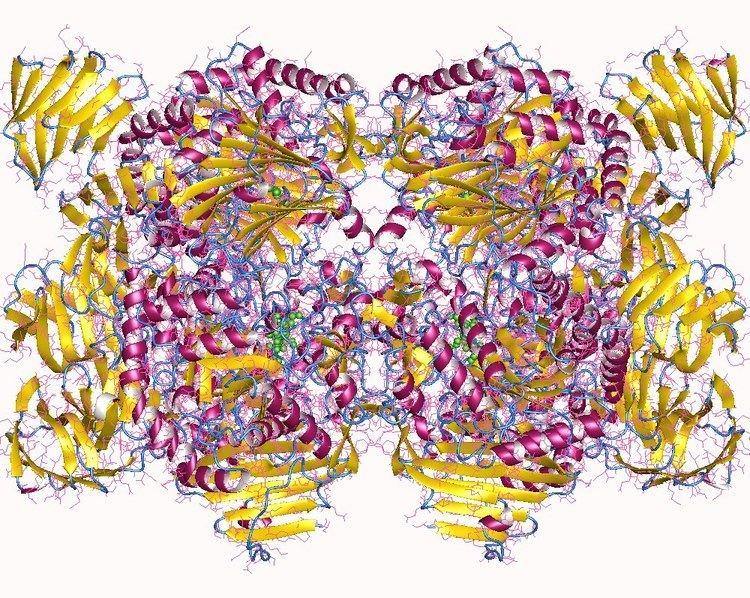Alpha-glucosidase (EC 3.2.1.20, maltase, glucoinvertase, glucosidosucrase, maltase-glucoamylase, alpha-glucopyranosidase, glucosidoinvertase, alpha-D-glucosidase, alpha-glucoside hydrolase, alpha-1,4-glucosidase, alpha-D-glucoside glucohydrolase) is a glucosidase located in the brush border of the small intestine that acts upon α(1→4) bonds. This is in contrast to beta-glucosidase. Alpha-glucosidase breaks down starch and disaccharides to glucose. Maltase, a similar enzyme that cleaves maltose, is nearly functionally equivalent.
Other glucosidases include:
Cellulase
Beta-glucosidase
Debranching enzyme
Alpha-glucosidase hydrolyzes terminal non-reducing (1→4)-linked alpha-glucose residues to release a single alpha-glucose molecule. Alpha-glucosidase is a carbohydrate-hydrolase that releases alpha-glucose as opposed to beta-glucose. Beta-glucose residues can be released by glucoamylase, a functionally similar enzyme. The substrate selectivity of alpha-glucosidase is due to subsite affinities of the enzyme’s active site. Two proposed mechanisms include a nucleophilic displacement and an oxocarbenium ion intermediate.
Rhodnius prolixus, a blood-sucking insect, forms hemozoin (Hz) during digestion of host hemoglobin. Hemozoin synthesis is dependent on the substrate binding site of alpha-glucosidase.
Trout liver alpha-glucosidases were extracted and characterized. It was shown that for one of the trout liver alpha-glucosidases maximum activity of the enzyme was increased by 80% during exercise in comparison to a resting trout. This change was shown to correlate to an activity increase for liver glycogen phosphorylase. It is proposed that alpha-glucosidase in the glucosidic path plays an important part in complementing the phosphorolytic pathway in the liver’s metabolic response to energy demands of exercise.
Yeast and rat small intestinal alpha-glucosidases have been shown to be inhibited by several groups of flavonoids.
Alpha-glucosidases can potentially be split, according to primary structure, into two families. The gene coding for human lysosomal alpha-glucosidase is about 20 kb long and its structure has been cloned and confirmed.
Human lysosomal alpha-glucosidase has been studied for the significance of the Asp-518 and other residues in proximity of the enzyme’s active site. It was found that substituting Asp-513 with Glu-513 interferes with posttranslational modification and intracellular transport of alpha-glucosidase’s precursor. Additionally, the Trp-516 and Asp-518 residues have been deemed critical for the enzyme’s catalytic functionality.
Kinetic changes in alpha-glucosidase have been shown to be induced by denaturants such as guanidinium chloride (GdmCl) and SDS solutions. These denaturants cause loss of activity and conformational change. A loss of enzyme activity occurs at much lower concentrations of denaturant than required for conformational changes. This leads to a conclusion that the enzyme’s active site conformation is less stable than the whole enzyme conformation in response to the two denaturants.
Pompe disease: a disorder in which alpha-glucosidase is deficient. In 2006, the drug alglucosidase alfa became the first released treatment for Pompe disease and acts as an analog to alpha-glucosidase. Further studies of alglucosidase alfa revealed that iminosugars exhibit inhibition of the enzyme. It was found that one compound molecule binds to a single enzyme molecule. It was shown that 1-deoxynojirimycin (DNJ) would bind the strongest of the sugars tested and blocked the active site of the enzyme almost entirely. The studies enhanced knowledge of the mechanism by which alpha-glucosidase binds to imino sugars.
Diabetes: Acarbose, an alpha-glucosidase inhibitor, competitively and reversibly inhibits alpha-glucosidase in the intestines. This inhibition lowers the rate of glucose absorption through delayed carbohydrate digestion and extended digestion time. Acarbose may have the capability to stop developing diabetic symptoms. Hence, alpha-glucosidase inhibitors (like acarbose) are used as anti-diabetic drugs in combination with other anti-diabetic drugs. Luteolin has been found to be a strong inhibitor of alpha-glucosidase. The compound can inhibit the enzyme up to 36% with a concentration of 0.5 mg/ml. As of 2016, this substance is being tested in rats, mice and cell culture.
Azoospermia: Diagnosis of azoospermia has potential to be aided by measurement of alpha-glucosidase activity in seminal plasma. Activity in the seminal plasma corresponds to the functionality of the epididymis.
Antiviral agents: Many animal viruses possess an outer envelope composed of viral glycoproteins. These are often required for the viral life cycle and utilize cellular machinery for synthesis. Inhibitors of alpha-glucosidase show that the enzyme is involved in the pathway for N-glycans for viruses such as HIV and human hepatitis B virus (HBV). Inhibition of alpha-glucosidase can prevent fusion of HIV and secretion of HBV.

